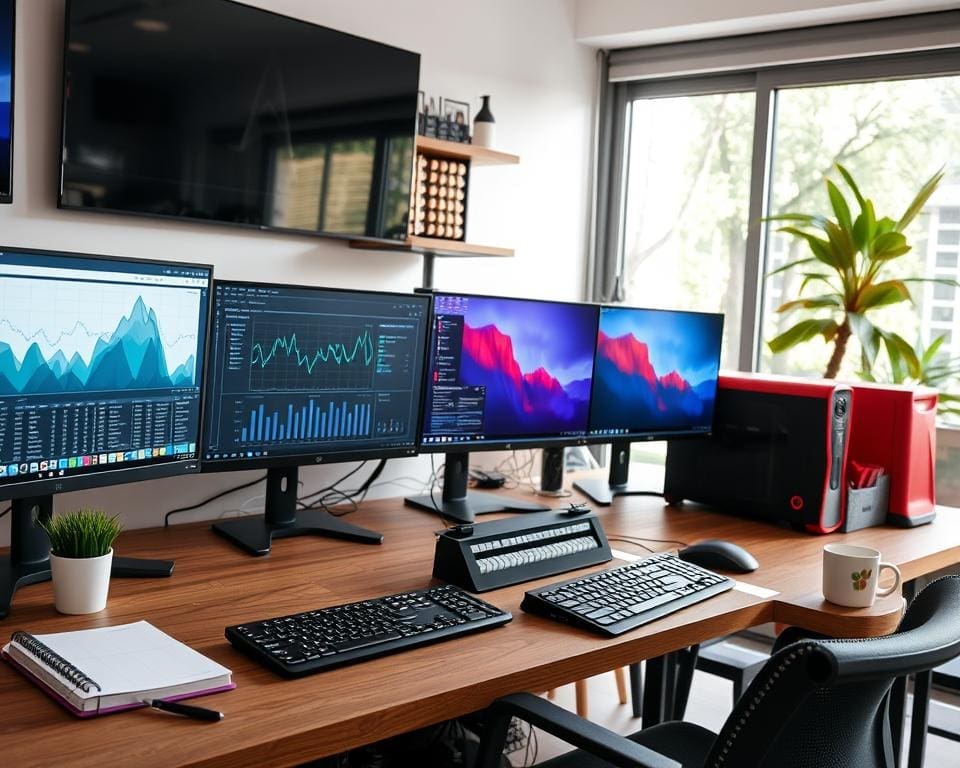In today’s fast-paced professional landscape, choosing the right desktop computer for work is essential for maximising productivity and efficiency. Every office desktop PC is designed to be the cornerstone of daily operations, whether you are handling administrative tasks or engaging in intricate design projects. By understanding the diverse range of desktop computers available, professionals can make informed decisions that align with their specific needs.
Key brands like Dell, HP, Lenovo, and Apple provide an impressive selection of professional desktop computers, each tailored for various work environments. The right investment in a quality desktop can significantly enhance workflow, streamline processes, and improve overall business outcomes.
Understanding Your Work Requirements
Choosing the right desktop computer requires a clear understanding of your specific work requirements. Each individual has unique needs that hinge on their responsibilities, which can significantly influence the type of machine best suited for their tasks.
Identifying Your Work Style
In the process of identifying your work style, consider whether your activities are primarily centred around standard office applications or delve into creative fields that necessitate more robust computing resources. If your tasks involve routine document creation and data management, a standard business computer may suffice. Conversely, those engaged in graphic design or video editing will need to invest in more powerful hardware.
Assessing Software Needs
The next step involves assessing software needs relevant to your work requirements. Familiarise yourself with the applications you will utilise regularly. If these programmes demand high performance, ensure that your chosen computer has the appropriate specifications to support them effectively. Compatibility with specialised software must also be a priority, as this can impact your operational efficiency.
Considering Hardware Performance
Finally, considering hardware performance is paramount when selecting a computer. Evaluate critical components such as processors, graphics cards, and memory, as these elements play a crucial role in the overall functionality of the machine. A well-rounded business computer will enhance productivity and ensure durability throughout its lifespan.

Choosing the Right Desktop Computer for Work
When choosing the right desktop computer for work, understanding the variety of options available is critical. Different types of desktop computers cater to unique professional requirements. By evaluating desktop computers, individuals can make informed decisions that align with their specific tasks and workflows.
Evaluating Different Types of Desktop Computers
Desktop computers come in many forms, from compact units to traditional towers. Each has its own advantages that can suit diverse work environments. Compact computers are ideal for limited spaces, whereas towers often offer better expansion options and performance capabilities. Understanding these variations aids professionals in making the best selection for their needs.
Workstation PCs vs. Standard Business Computers
Workstation PCs stand out for their exceptional performance, making them the preferred choice for demanding fields like graphic design and engineering. These machines are equipped with powerful components to handle resource-intensive applications seamlessly. On the other hand, standard business computers suffice for routine tasks such as document processing, spreadsheet management, and email functionality. Recognising the differences between workstation PCs and standard business computers allows users to choose a desktop that optimally supports their operational requirements.
Key Specifications to Look For
When selecting a desktop computer for work, understanding the key specifications is vital. This knowledge ensures that your device meets all necessary performance standards, enhancing productivity in your professional tasks.
Processor Power and Speed
The processor power is a critical element of any workstation. Popular series such as the Intel Core i5 and i7 or AMD Ryzen 5 and 7 provide excellent options depending on the level of computing power required. A faster processor translates to improved multitasking and a smoother operation for demanding applications.
Memory and Storage Requirements
Memory requirements play an integral role in your computer’s performance. For ordinary tasks, 8GB of RAM is sufficient, while more intensive work, such as graphic design or virtualisation, often demands 16GB or more. In terms of storage requirements, the inclusion of SSDs can significantly speed up access times compared to conventional HDDs. Many users find a combination of both storage types provides the ideal mix of speed and capacity.
Graphics Capabilities for Professional Use
Finally, graphics capabilities cannot be overlooked. For professionals working in design or video editing, having a capable graphics card is essential. Options from NVIDIA or AMD can greatly enhance rendering times and overall graphical performance, making your workflow significantly more efficient.
Budgeting for Your Office Desktop PC
Crafting an effective budget for your office desktop PC is crucial in today’s fast-paced work environment. By understanding your financial limits while seeking the right blend of specifications and features, you can ensure that your investment meets your professional needs. Desktop computers exhibit a vast range of prices; for instance, budget models suitable for basic tasks can be found for less than £500, while high-performance workstation PCs, designed to tackle more intensive workloads, can exceed £2,000.
When considering office desktop PC pricing, it is important to recognise that the initial purchase cost is just the beginning. Long-term costs, such as potential upgrades and maintenance, should also be factored into your budgeting for desktop PC strategy. Evaluating the longevity and serviceability of your chosen model can ultimately influence overall expenditure and productivity.
Moreover, researching various retailers, comparing models, and considering refurbished options can lead to substantial savings. Being strategic in your approach to business workstation costs means investing wisely in a desktop computer that offers both value and versatility, allowing for future growth and adaptability in your work environment.









